lock MAZDA MODEL MX-5 MIATA PRHT 2012 Owners Manual
[x] Cancel search | Manufacturer: MAZDA, Model Year: 2012, Model line: MODEL MX-5 MIATA PRHT, Model: MAZDA MODEL MX-5 MIATA PRHT 2012Pages: 456, PDF Size: 5.68 MB
Page 8 of 456
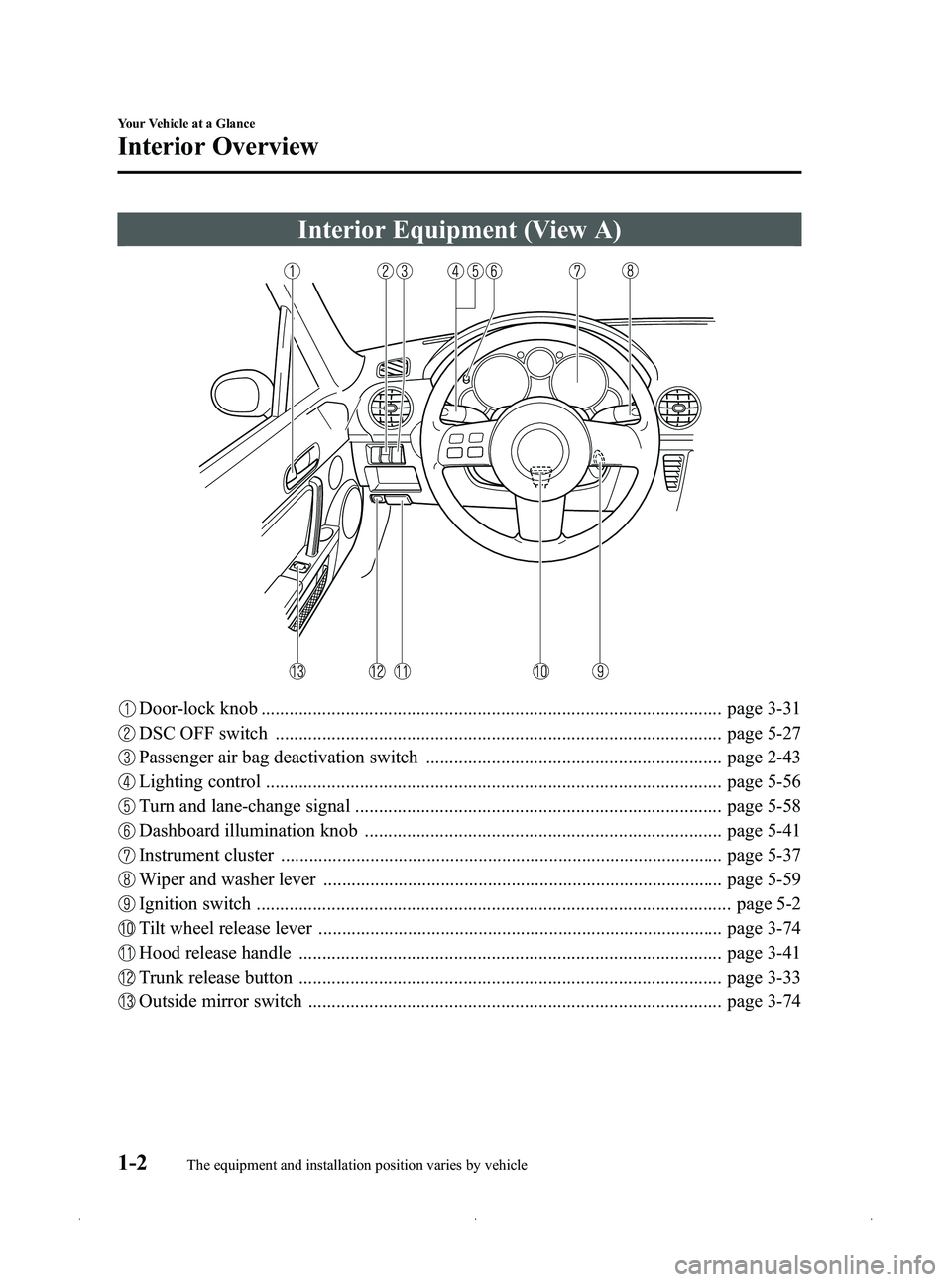
Black plate (8,1)
Interior Equipment (View A)
Door-lock knob .................................................................................................. page 3-31
DSC OFF switch ............................................................................................... page 5-27
Passenger air bag deactivation switch ............................................................... page 2-43
Lighting control ................................................................................................. page 5-56
Turn and lane-change signal .............................................................................. page 5-58
Dashboard illumination knob ............................................................................ page 5-41
Instrument cluster .............................................................................................. page 5-37
Wiper and washer lever ..................................................................................... page 5-59
Ignition switch ..................................................................................................... page 5-2
Tilt wheel release lever ...................................................................................... page 3-74
Hood release handle .......................................................................................... page 3-41
Trunk release button .......................................................................................... page 3-33
Outside mirror switch ........................................................................................ page 3-74
1-2
Your Vehicle at a Glance
The equipment and installation position varies by vehicle
Interior Overview
MX-5_8CC1-EA-11F_Edition2 Page8
Monday, July 18 2011 10:7 AM
Form No.8CC1-EA-11F
Page 10 of 456
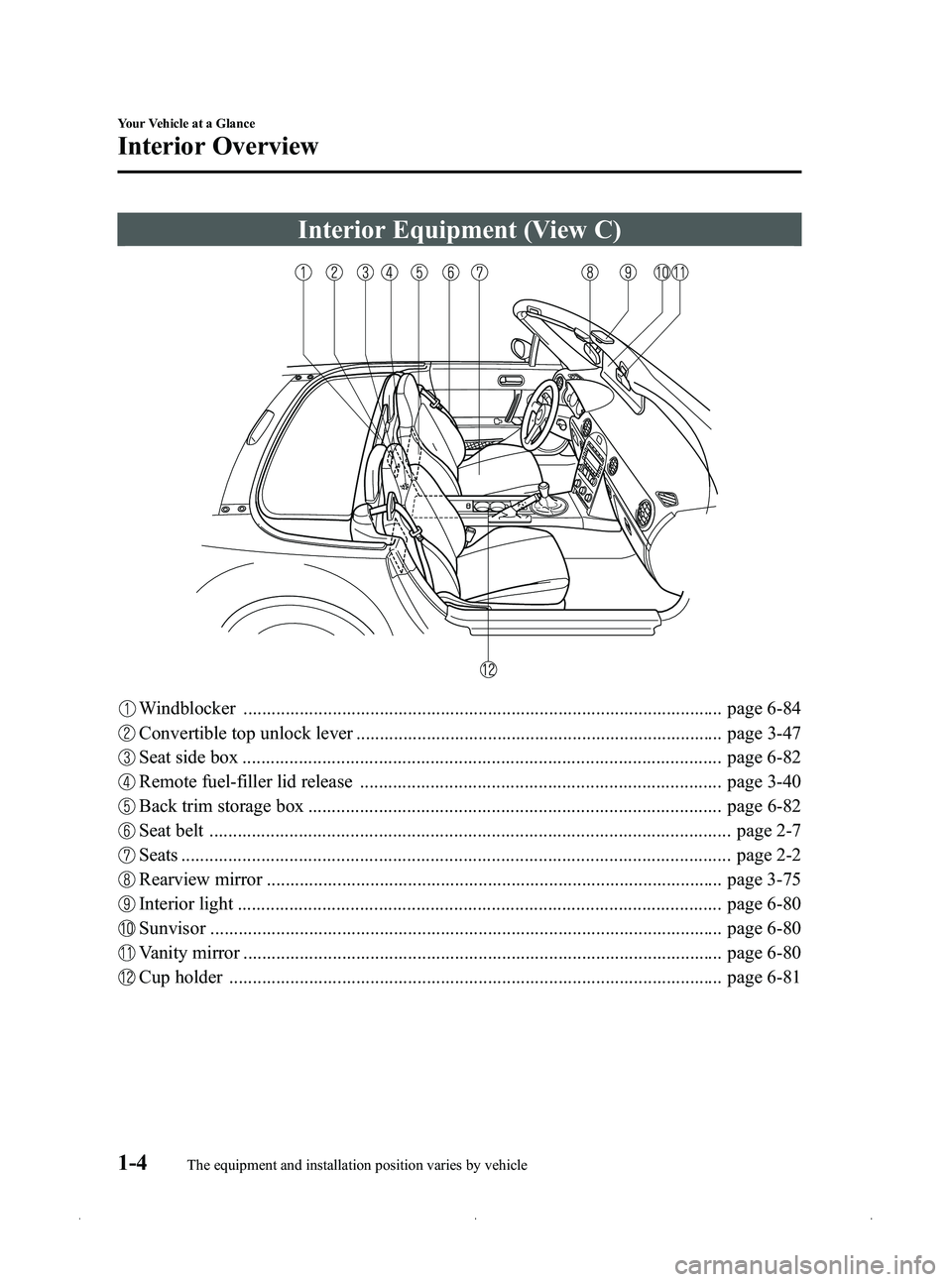
Black plate (10,1)
Interior Equipment (View C)
Windblocker ...................................................................................................... page 6-84
Convertible top unlock lever .............................................................................. page 3-47
Seat side box ...................................................................................................... page 6-82
Remote fuel-filler lid release ............................................................................. page 3-40
Back trim storage box ........................................................................................ page 6-82
Seat belt ............................................................................................................... page 2-7
Seats ..................................................................................................................... page 2-2
Rearview mirror ................................................................................................. page 3-75
Interior light ....................................................................................................... page 6-80
Sunvisor ............................................................................................................. page 6-80
Vanity mirror ...................................................................................................... page 6-80
Cup holder ......................................................................................................... page 6-81
1-4
Your Vehicle at a Glance
The equipment and installation position varies by vehicle
Interior Overview
MX-5_8CC1-EA-11F_Edition2 Page10
Monday, July 18 2011 10:7 AM
Form No.8CC1-EA-11F
Page 14 of 456
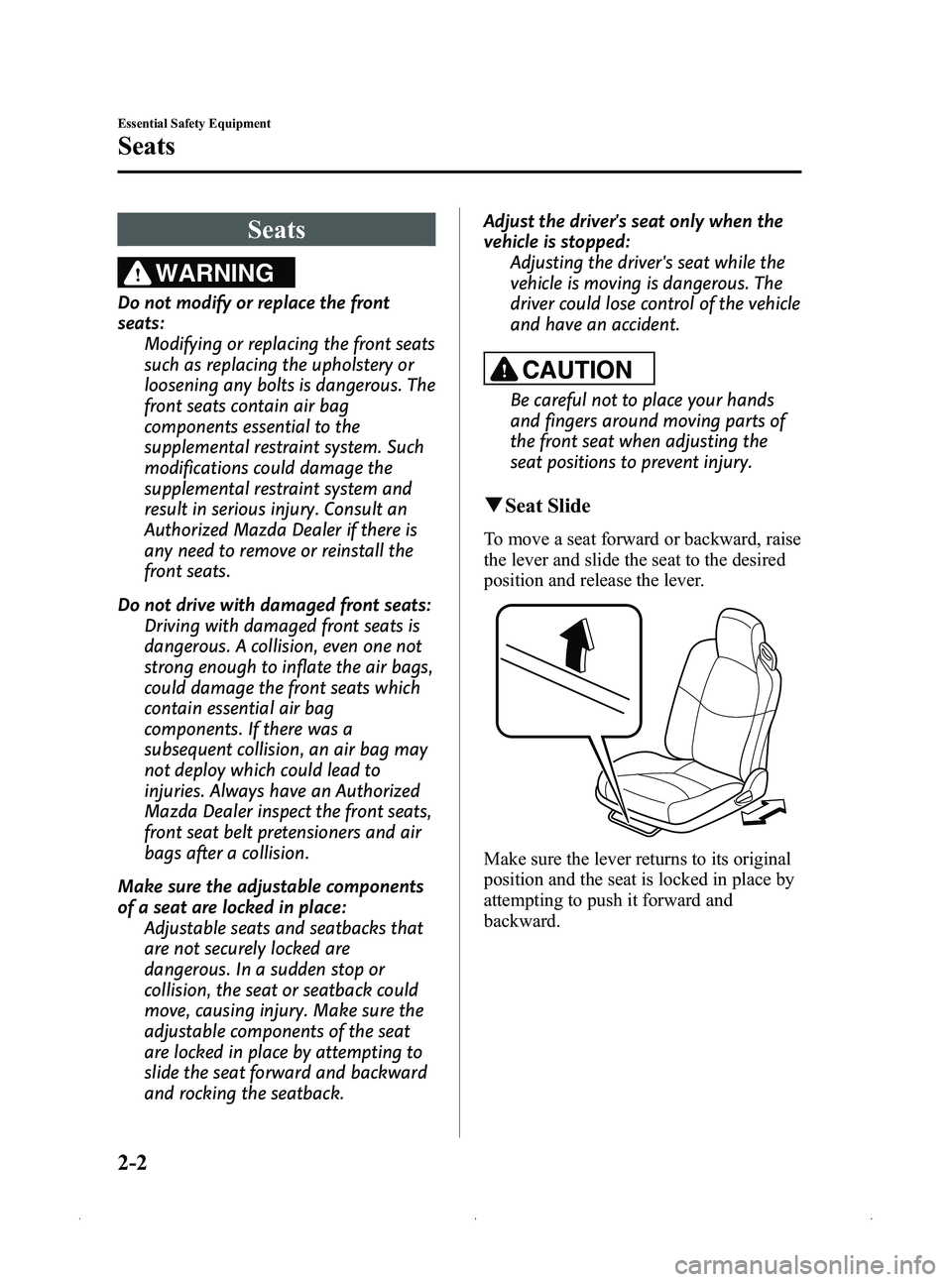
Black plate (14,1)
Seats
WARNING
Do not modify or replace the front
seats:Modifying or replacing the front seats
such as replacing the upholstery or
loosening any bolts is dangerous. The
front seats contain air bag
components essential to the
supplemental restraint system. Such
modifications could damage the
supplemental restraint system and
result in serious injury. Consult an
Authorized Mazda Dealer if there is
any need to remove or reinstall the
front seats.
Do not drive with damaged front seats: Driving with damaged front seats is
dangerous. A collision, even one not
strong enough to inflate the air bags,
could damage the front seats which
contain essential air bag
components. If there was a
subsequent collision, an air bag may
not deploy which could lead to
injuries. Always have an Authorized
Mazda Dealer inspect the front seats,
front seat belt pretensioners and air
bags after a collision.
Make sure the adjustable components
of a seat are locked in place: Adjustable seats and seatbacks that
are not securely locked are
dangerous. In a sudden stop or
collision, the seat or seatback could
move, causing injury. Make sure the
adjustable components of the seat
are locked in place by attempting to
slide the seat forward and backward
and rocking the seatback. Adjust the driver's seat only when the
vehicle is stopped:
Adjusting the driver's seat while the
vehicle is moving is dangerous. The
driver could lose control of the vehicle
and have an accident.
CAUTION
Be careful not to place your hands
and fingers around moving parts of
the front seat when adjusting the
seat positions to prevent injury.
qSeat Slide
To move a seat forward or backward, raise
the lever and slide the seat to the desired
position and release the lever.
Make sure the lever returns to its original
position and the seat is locked in place by
attempting to push it forward and
backward.
2-2
Essential Safety Equipment
Seats
MX-5_8CC1-EA-11F_Edition2 Page14
Monday, July 18 2011 10:7 AM
Form No.8CC1-EA-11F
Page 15 of 456
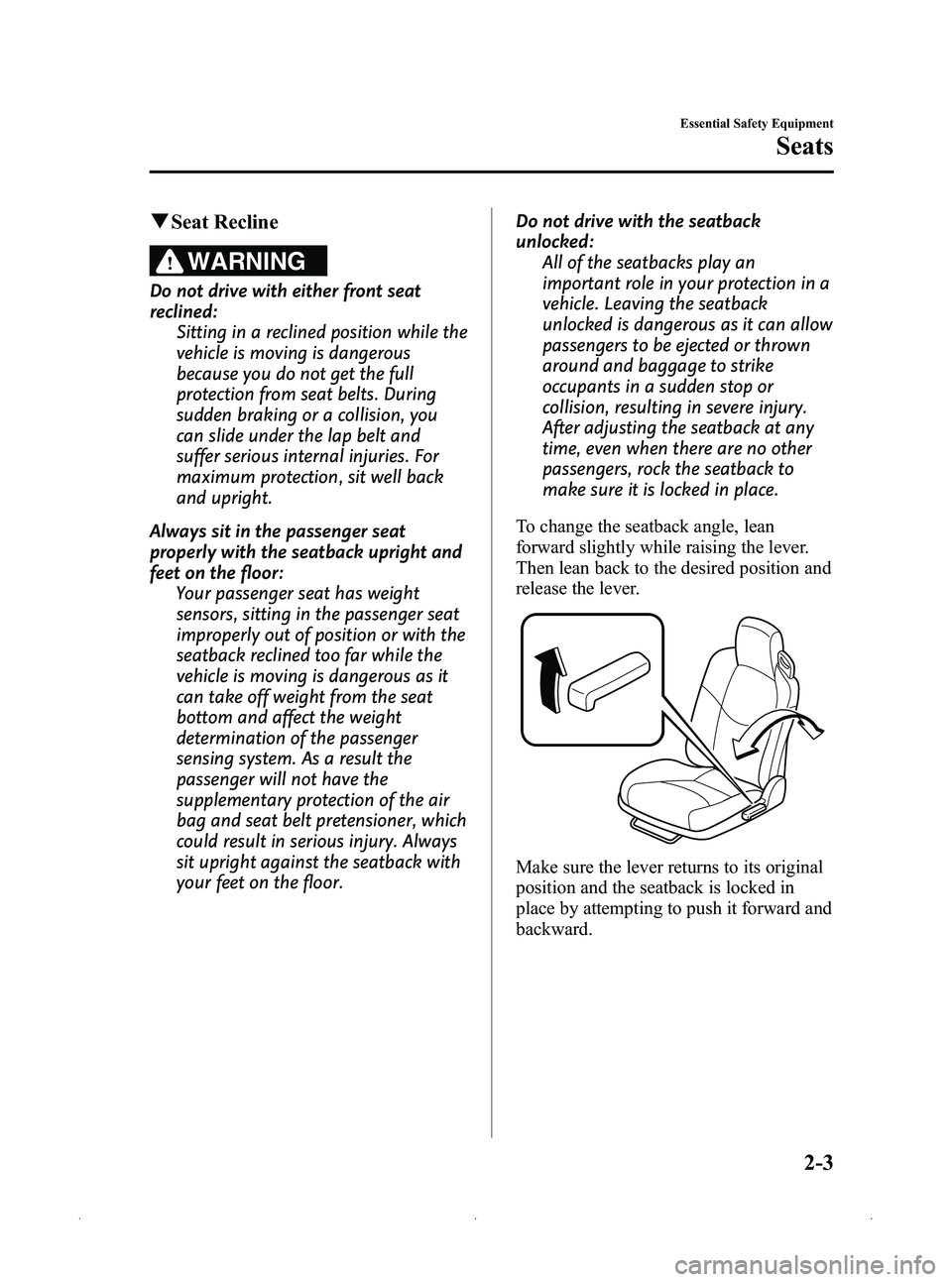
Black plate (15,1)
qSeat Recline
WARNING
Do not drive with either front seat
reclined:
Sitting in a reclined position while the
vehicle is moving is dangerous
because you do not get the full
protection from seat belts. During
sudden braking or a collision, you
can slide under the lap belt and
suffer serious internal injuries. For
maximum protection, sit well back
and upright.
Always sit in the passenger seat
properly with the seatback upright and
feet on the floor: Your passenger seat has weight
sensors, sitting in the passenger seat
improperly out of position or with the
seatback reclined too far while the
vehicle is moving is dangerous as it
can take off weight from the seat
bottom and affect the weight
determination of the passenger
sensing system. As a result the
passenger will not have the
supplementary protection of the air
bag and seat belt pretensioner, which
could result in serious injury. Always
sit upright against the seatback with
your feet on the floor. Do not drive with the seatback
unlocked:
All of the seatbacks play an
important role in your protection in a
vehicle. Leaving the seatback
unlocked is dangerous as it can allow
passengers to be ejected or thrown
around and baggage to strike
occupants in a sudden stop or
collision, resulting in severe injury.
After adjusting the seatback at any
time, even when there are no other
passengers, rock the seatback to
make sure it is locked in place.
To change the seatback angle, lean
forward slightly while raising the lever.
Then lean back to the desired position and
release the lever.
Make sure the lever returns to its original
position and the seatback is locked in
place by attempting to push it forward and
backward.
Essential Safety Equipment
Seats
2-3
MX-5_8CC1-EA-11F_Edition2 Page15
Monday, July 18 2011 10:7 AM
Form No.8CC1-EA-11F
Page 19 of 456
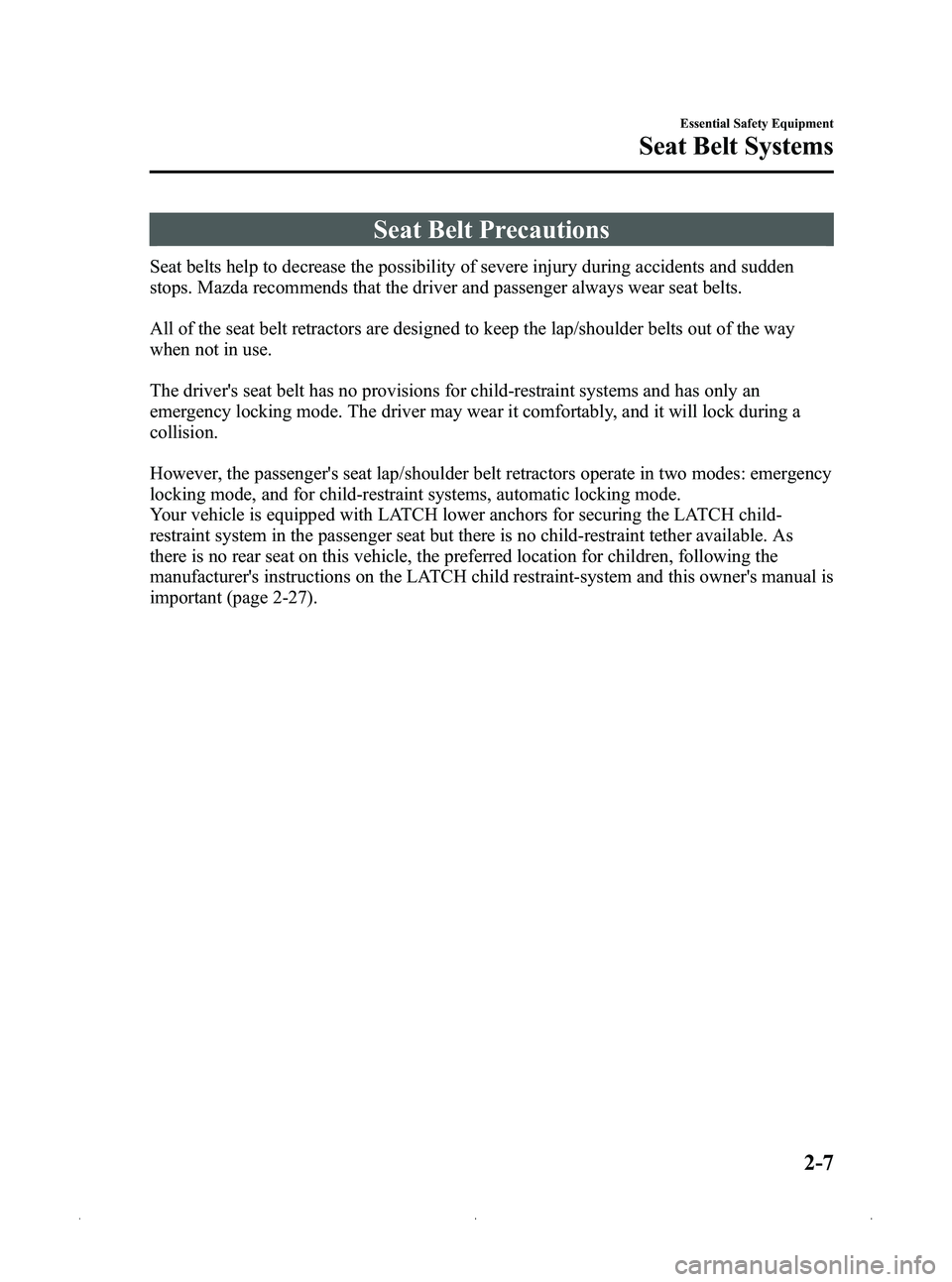
Black plate (19,1)
Seat Belt Precautions
Seat belts help to decrease the possibility of severe injury during accidents and sudden
stops. Mazda recommends that the driver and passenger always wear seat belts.
All of the seat belt retractors are designed to keep the lap/shoulder belts out of the way
when not in use.
The driver's seat belt has no provisions for child-restraint systems and has only an
emergency locking mode. The driver may wear it comfortably, and it will lock during a
collision.
However, the passenger's seat lap/shoulder belt retractors operate in two modes: emergency
locking mode, and for child-restraint systems, automatic locking mode.
Your vehicle is equipped with LATCH lower anchors for securing the LATCH child-
restraint system in the passenger seat but there is no child-restraint tether available. As
there is no rear seat on this vehicle, the preferred location for children, following the
manufacturer's instructions on the LATCH child restraint-system and this owner's manual is
important (page 2-27).
Essential Safety Equipment
Seat Belt Systems
2-7
MX-5_8CC1-EA-11F_Edition2 Page19
Monday, July 18 2011 10:7 AM
Form No.8CC1-EA-11F
Page 21 of 456
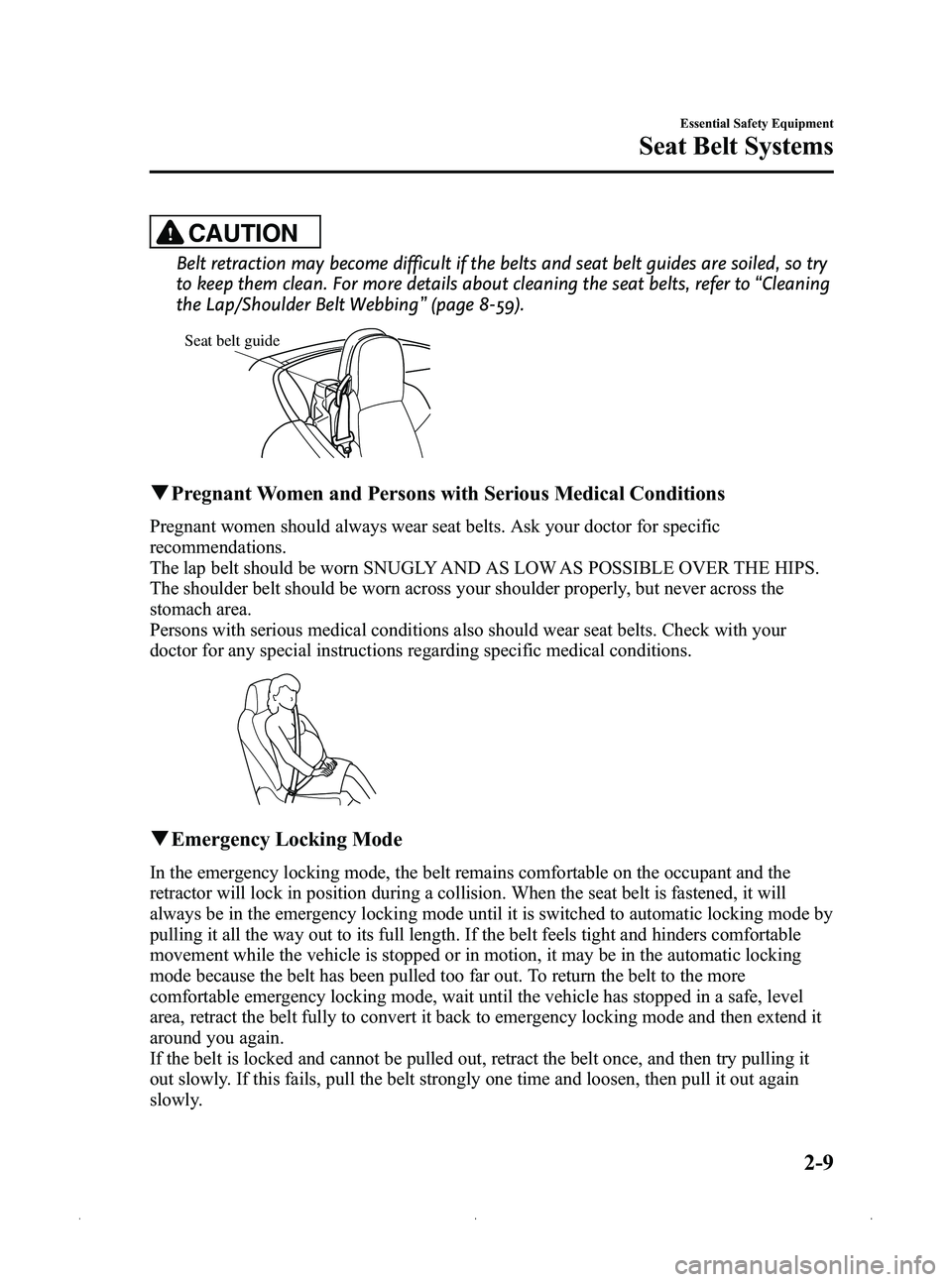
Black plate (21,1)
CAUTION
Belt retraction may become difficult if the belts and seat belt guides are soiled, so try
to keep them clean. For more details about cleaning the seat belts, refer to“Cleaning
the Lap/Shoulder Belt Webbing ”(page 8-59).
Seat belt guide
q Pregnant Women and Persons with Serious Medical Conditions
Pregnant women should always wear seat belts. Ask your doctor for specific
recommendations.
The lap belt should be worn SNUGLY AND AS LOW AS POSSIBLE OVER THE HIPS.
The shoulder belt should be worn across your shoulder properly, but never across the
stomach area.
Persons with serious medical conditions also should wear seat belts. Check with your
doctor for any special instructions regarding specific medical conditions.
qEmergency Locking Mode
In the emergency locking mode, the belt remains comfortable on the occupant and the
retractor will lock in position during a collision. When the seat belt is fastened, it will
always be in the emergency locking mode until it is switched to automatic locking mode by
pulling it all the way out to its full length. If the belt feels tight and hinders comfortable
movement while the vehicle is stopped or in motion, it may be in the automatic locking
mode because the belt has been pulled too far out. To return the belt to the more
comfortable emergency locking mode, wait until the vehicle has stopped in a safe, level
area, retract the belt fully to convert it back to emergency locking mode and then extend it
around you again.
If the belt is locked and cannot be pulled out, retract the belt once, and then try pulling it
out slowly. If this fails, pull the belt strongly one time and loosen, then pull it out again
slowly.
Essential Safety Equipment
Seat Belt Systems
2-9
MX-5_8CC1-EA-11F_Edition2 Page21
Monday, July 18 2011 10:7 AM
Form No.8CC1-EA-11F
Page 22 of 456
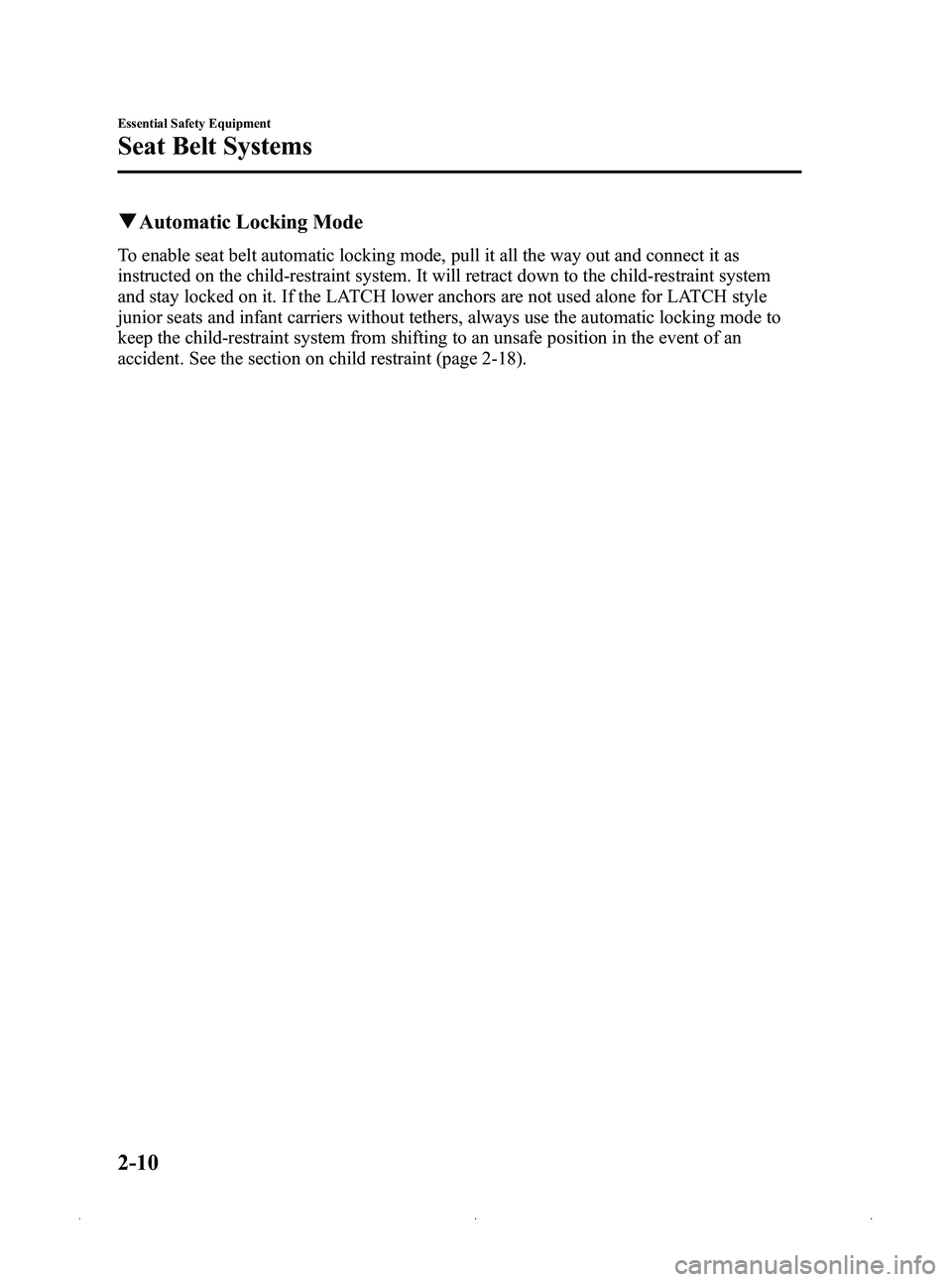
Black plate (22,1)
qAutomatic Locking Mode
To enable seat belt automatic locking mode, pull it all the way out and connect it as
instructed on the child-restraint system. It will retract down to the child-restraint system
and stay locked on it. If the LATCH lower anchors are not used alone for LATCH style
junior seats and infant carriers without tethers, always use the automatic locking mode to
keep the child-restraint system from shifting to an unsafe position in the event of an
accident. See the section on child restraint (page 2-18).
2-10
Essential Safety Equipment
Seat Belt Systems
MX-5_8CC1-EA-11F_Edition2 Page22
Monday, July 18 2011 10:7 AM
Form No.8CC1-EA-11F
Page 31 of 456
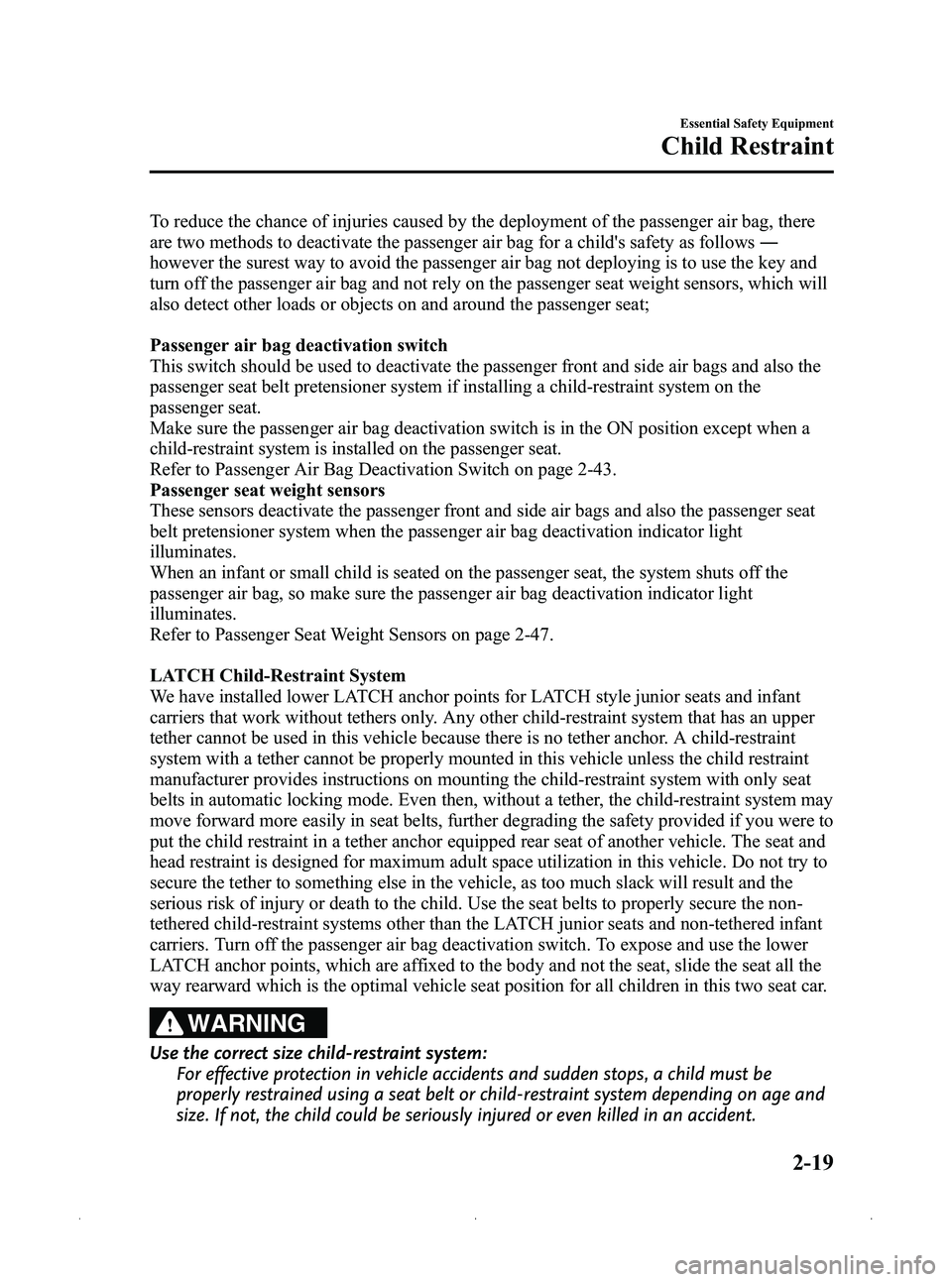
Black plate (31,1)
To reduce the chance of injuries caused by the deployment of the passenger air bag, there
are two methods to deactivate the passenger air bag for a child's safety as follows―
however the surest way to avoid the passenger air bag not deploying is to use the key and
turn off the passenger air bag and not rely on the passenger seat weight sensors, which will
also detect other loads or objects on and around the passenger seat;
Passenger air bag deactivation switch
This switch should be used to deactivate the passenger front and side air bags and also the
passenger seat belt pretensioner system if installing a child-restraint system on the
passenger seat.
Make sure the passenger air bag deactivation switch is in the ON position except when a
child-restraint system is installed on the passenger seat.
Refer to Passenger Air Bag Deactivation Switch on page 2-43.
Passenger seat weight sensors
These sensors deactivate the passenger front and side air bags and also the passenger seat
belt pretensioner system when the passenger air bag deactivation indicator light
illuminates.
When an infant or small child is seated on the passenger seat, the system shuts off the
passenger air bag, so make sure the passenger air bag deactivation indicator light
illuminates.
Refer to Passenger Seat Weight Sensors on page 2-47.
LATCH Child-Restraint System
We have installed lower LATCH anchor points for LATCH style junior seats and infant
carriers that work without tethers only. Any other child-restraint system that has an upper
tether cannot be used in this vehicle because there is no tether anchor. A child-restraint
system with a tether cannot be properly mounted in this vehicle unless the child restraint
manufacturer provides instructions on mounting the child-restraint system with only seat
belts in automatic locking mode. Even then, without a tether, the child-restraint system may
move forward more easily in seat belts, further degrading the safety provided if you were to
put the child restraint in a tether anchor equipped rear seat of another vehicle. The seat and
head restraint is designed for maximum adult space utilization in this vehicle. Do not try to
secure the tether to something else in the vehicle, as too much slack will result and the
serious risk of injury or death to the child. Use the seat belts to properly secure the non-
tethered child-restraint systems other than the LATCH junior seats and non-tethered infant
carriers. Turn off the passenger air bag deactivation switch. To expose and use the lower
LATCH anchor points, which are affixed to the body and not the seat, slide the seat all the
way rearward which is the optimal vehicle seat position for all children in this two seat car.
WARNING
Use the correct size child-restraint system: For effective protection in vehicle accidents and sudden stops, a child must be
properly restrained using a seat belt or child-restraint system depending on age and
size. If not, the child could be seriously injured or even killed in an accident.
Essential Safety Equipment
Child Restraint
2-19
MX-5_8CC1-EA-11F_Edition2 Page31
Monday, July 18 2011 10:7 AM
Form No.8CC1-EA-11F
Page 33 of 456
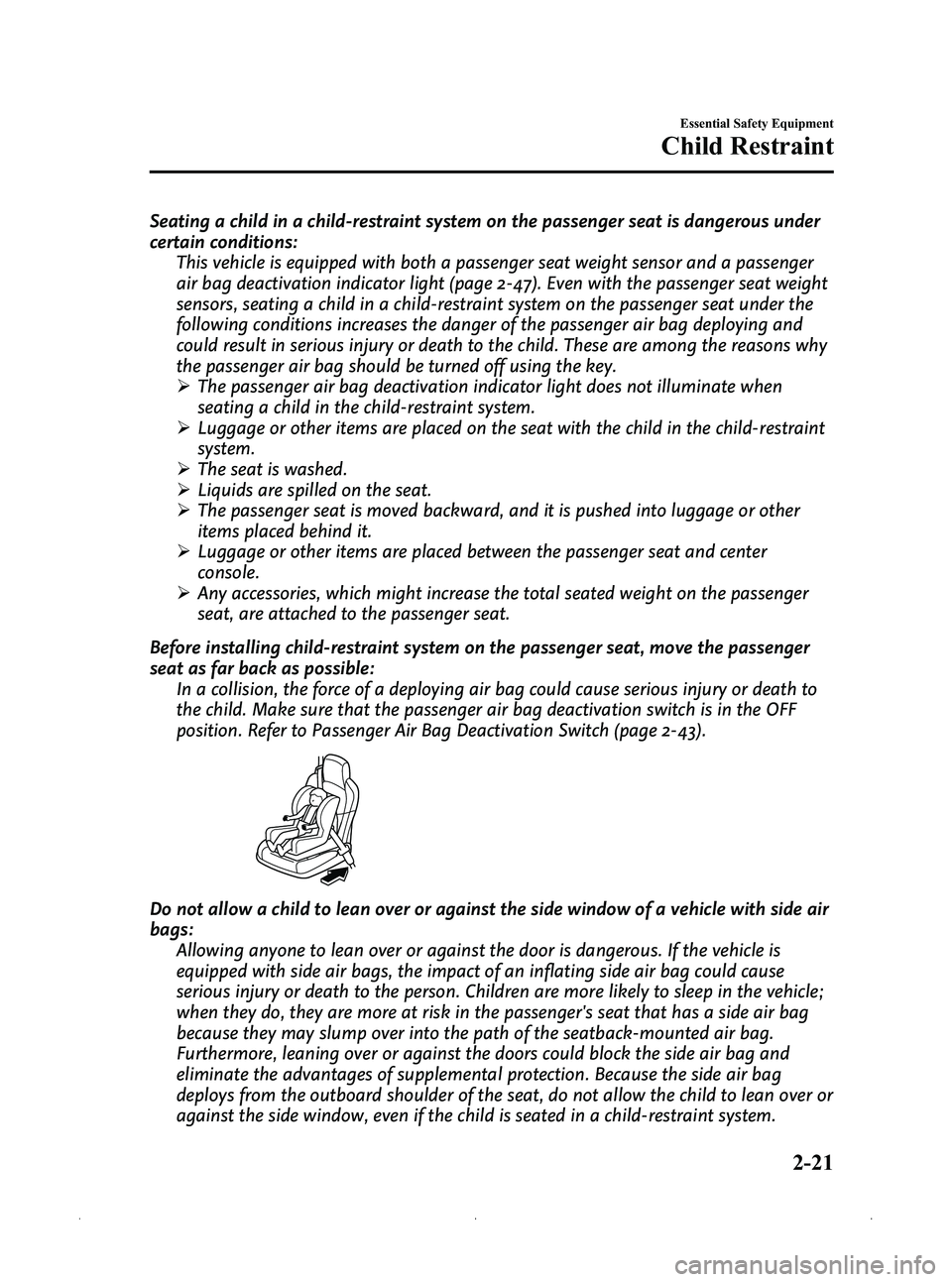
Black plate (33,1)
Seating a child in a child-restraint system on the passenger seat is dangerous under
certain conditions:This vehicle is equipped with both a passenger seat weight sensor and a passenger
air bag deactivation indicator light (page 2-47). Even with the passenger seat weight
sensors, seating a child in a child-restraint system on the passenger seat under the
following conditions increases the danger of the passenger air bag deploying and
could result in serious injury or death to the child. These are among the reasons why
the passenger air bag should be turned off using the key.
ØThe passenger air bag deactivation indicator light does not illuminate when
seating a child in the child-restraint system.
Ø Luggage or other items are placed on the seat with the child in the child-restraint
system.
Ø The seat is washed.
Ø Liquids are spilled on the seat.
Ø The passenger seat is moved backward, and it is pushed into luggage or other
items placed behind it.
Ø Luggage or other items are placed between the passenger seat and center
console.
Ø Any accessories, which might increase the total seated weight on the passenger
seat, are attached to the passenger seat.
Before installing child-restraint system on the passenger seat, move the passenger
seat as far back as possible: In a collision, the force of a deploying air bag could cause serious injury or death to
the child. Make sure that the passenger air bag deactivation switch is in the OFF
position. Refer to Passenger Air Bag Deactivation Switch (page 2-43).
Do not allow a child to lean over or against the side window of a vehicle with side air
bags:Allowing anyone to lean over or against the door is dangerous. If the vehicle is
equipped with side air bags, the impact of an inflating side air bag could cause
serious injury or death to the person. Children are more likely to sleep in the vehicle;
when they do, they are more at risk in the passenger's seat that has a side air bag
because they may slump over into the path of the seatback-mounted air bag.
Furthermore, leaning over or against the doors could block the side air bag and
eliminate the advantages of supplemental protection. Because the side air bag
deploys from the outboard shoulder of the seat, do not allow the child to lean over or
against the side window, even if the child is seated in a child-restraint system.
Essential Safety Equipment
Child Restraint
2-21
MX-5_8CC1-EA-11F_Edition2 Page33
Monday, July 18 2011 10:7 AM
Form No.8CC1-EA-11F
Page 36 of 456
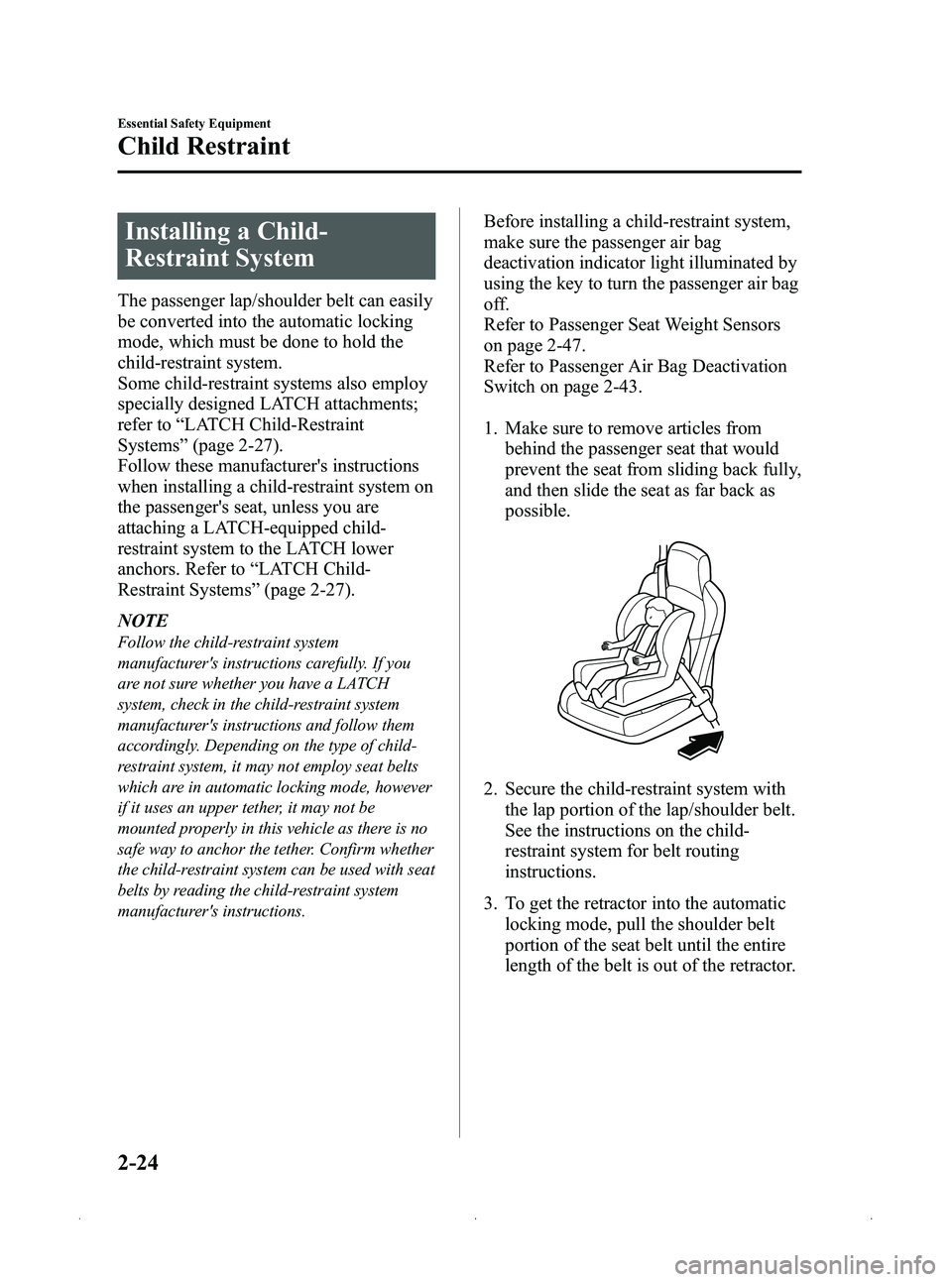
Black plate (36,1)
Installing a Child-
Restraint System
The passenger lap/shoulder belt can easily
be converted into the automatic locking
mode, which must be done to hold the
child-restraint system.
Some child-restraint systems also employ
specially designed LATCH attachments;
refer to“LATCH Child-Restraint
Systems ”(page 2-27).
Follow these manufacturer's instructions
when installing a child-restraint system on
the passenger's seat, unless you are
attaching a LATCH-equipped child-
restraint system to the LATCH lower
anchors. Refer to “LATCH Child-
Restraint Systems ”(page 2-27).
NOTE
Follow the child-restraint system
manufacturer's instructions carefully. If you
are not sure whether you have a LATCH
system, check in the child-restraint system
manufacturer's instructions and follow them
accordingly. Depending on the type of child-
restraint system, it may not employ seat belts
which are in automatic locking mode, however
if it uses an upper tether, it may not be
mounted properly in this vehicle as there is no
safe way to anchor the tether. Confirm whether
the child-restraint system can be used with seat
belts by reading the child-restraint system
manufacturer's instructions.
Before installing a child-restraint system,
make sure the passenger air bag
deactivation indicator light illuminated by
using the key to turn the passenger air bag
off.
Refer to Passenger Seat Weight Sensors
on page 2-47.
Refer to Passenger Air Bag Deactivation
Switch on page 2-43.
1. Make sure to remove articles from behind the passenger seat that would
prevent the seat from sliding back fully,
and then slide the seat as far back as
possible.
2. Secure the child-restraint system with
the lap portion of the lap/shoulder belt.
See the instructions on the child-
restraint system for belt routing
instructions.
3. To get the retractor into the automatic locking mode, pull the shoulder belt
portion of the seat belt until the entire
length of the belt is out of the retractor.
2-24
Essential Safety Equipment
Child Restraint
MX-5_8CC1-EA-11F_Edition2 Page36
Monday, July 18 2011 10:7 AM
Form No.8CC1-EA-11F